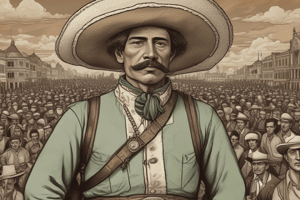Podcast
Questions and Answers
According to Huntington, what is a key aspect of modernization that can lead to revolution?
According to Huntington, what is a key aspect of modernization that can lead to revolution?
The demand for increased participation in politics.
How do the twentieth-century revolutions differ from the pattern described by Marx and Engels?
How do the twentieth-century revolutions differ from the pattern described by Marx and Engels?
They occurred in relatively poor countries undergoing early stages of modernization, with peasants often playing a major role, rather than in advanced capitalist societies with industrial laborers.
What is the central question scholars are now investigating regarding modernization and revolution?
What is the central question scholars are now investigating regarding modernization and revolution?
Whether modernization leads to a change in the balance of power among groups contending for political power.
How did the revolutions of the 20th century influence scholars' views regarding Marx's theories?
How did the revolutions of the 20th century influence scholars' views regarding Marx's theories?
Besides the French Revolution, name three other revolutions mentioned as significant topics of study.
Besides the French Revolution, name three other revolutions mentioned as significant topics of study.
What type of state do revolutions often lead to and why?
What type of state do revolutions often lead to and why?
What role have peasants played in socialist revolutions, according to the text, and how does this contrast with traditional Marxist theory?
What role have peasants played in socialist revolutions, according to the text, and how does this contrast with traditional Marxist theory?
Identify one country mentioned in the text that underwent a revolution in the 1950s or 1960s.
Identify one country mentioned in the text that underwent a revolution in the 1950s or 1960s.
What are the two phases involved in a complete revolution?
What are the two phases involved in a complete revolution?
How does the text define political modernization and political development, and how do these relate to the occurrence of revolutions?
How does the text define political modernization and political development, and how do these relate to the occurrence of revolutions?
In what type of societies are revolutions most likely to occur, and why?
In what type of societies are revolutions most likely to occur, and why?
What distinguishes a revolution from mere 'change,' according to the text?
What distinguishes a revolution from mere 'change,' according to the text?
How does the text measure the 'success' of a revolution?
How does the text measure the 'success' of a revolution?
Explain the text's assertion that revolution is a historically limited phenomenon, not a universal category.
Explain the text's assertion that revolution is a historically limited phenomenon, not a universal category.
What, according to the text, is the 'political essence' of revolution?
What, according to the text, is the 'political essence' of revolution?
What two factors determine how revolutionary a revolution is?
What two factors determine how revolutionary a revolution is?
What are the key characteristics that distinguish a revolution from a simple revolt or coup?
What are the key characteristics that distinguish a revolution from a simple revolt or coup?
How does a war of independence differ from a revolution, according to the text?
How does a war of independence differ from a revolution, according to the text?
Why are revolutions considered rare events in the history of societies?
Why are revolutions considered rare events in the history of societies?
In what way is revolution connected to modernization, as described in the text?
In what way is revolution connected to modernization, as described in the text?
The text mentions French, Chinese, Mexican, Russian, and Cuban revolutions. What common characteristic might these revolutions share that qualifies them as 'great' or 'social' revolutions?
The text mentions French, Chinese, Mexican, Russian, and Cuban revolutions. What common characteristic might these revolutions share that qualifies them as 'great' or 'social' revolutions?
Explain why the author claims that violence is not adequate to describe the essence of revolution.
Explain why the author claims that violence is not adequate to describe the essence of revolution.
Based on the text, how would you classify a change in government brought about by peaceful democratic elections? Would this be considered a revolution?
Based on the text, how would you classify a change in government brought about by peaceful democratic elections? Would this be considered a revolution?
How does the text suggest that the concept of revolution reflects a shift in the perception of human agency in shaping society?
How does the text suggest that the concept of revolution reflects a shift in the perception of human agency in shaping society?
Study Notes
- French Revolution no longer dominates discussions of revolution in the 21st century.
- Scholars now consider twentieth-century revolutions in places like Mexico (1910), Russia (1917), China (1911-1949), Persia (1905), Ottoman Empire (1919), Vietnam, Bolivia, and Cuba (1950s-1960s).
- Revolutions often led to stronger, centralized, and bureaucratic states.
- Origins of revolutions often differed from Marx and Engels' pattern.
- Socialist revolutions occurred in poorer countries just beginning modernization.
- Peasants played significant roles, not just industrial laborers.
- Scholars reinvestigate the causes of revolution and connections between modernization and revolution, since revolutions can arise in ways not foreseen by Marx.
- Modernization doesn't necessarily lead to revolution as the key issue is whether it changes the balance of power among groups contending for political power.
Revolution and Political Order
- Samuel P. Huntington argues that modernization increases the demand for political participation.
- Lack of access to political power for certain groups can lead to demands for change and revolution.
- The discussion covers revolutions in France, Russia, China, Mexico, Turkey, Vietnam, and Persia (Iran under the Qajar dynasty in 1925).
- Huntington identifies patterns of revolution, examining roles of moderates, counterrevolutionaries, and radicals.
- Revolution involves rapid, fundamental, and violent domestic change in dominant values, myths, political institutions, social structure, leadership, and government.
- Revolutions differ from insurrections, rebellions, revolts, coups, and wars of independence.
- Coup d'etat changes leadership/policies, rebellion/insurrection changes policies/leadership/political institutions.
- War of independence is a struggle of one community against rule by an alien community, not necessarily changing social structure.
- Examples include the French, Chinese, Mexican, Russian, and Cuban revolutions.
- Most societies/ages haven't experienced revolutions indicating revolution is characteristic of modernization.
- Revolution is the ultimate expression of the modernizing outlook, believing that it is within man's power to control and to change his environment and that he has not only the ability but the right to do so.
- Violence in revolution is used to constitute an altogether different form of government.
- Revolution is an aspect of modernization, a historically limited phenomenon that will not occur in highly traditional societies or highly modern societies.
- Likely to occur in societies with some socio-economic development where political modernization/development lags behind socio-economic change.
- Political modernization extends political consciousness/mobilization to new social groups.
- Political development creates adaptable, complex, autonomous, and coherent institutions to absorb/order the participation of new groups and promote socio-economic change.
- The political essence of revolution is the rapid expansion of political consciousness.
- Rapid mobilization of new groups exceeds the assimilation capacity of existing political institutions.
- Revolution is the extreme case of the explosion of political participation.
- A complete revolution involves both political mobilization and creating/institutionalizing a new political order.
- The measure of how revolutionary something is, is the rapidity and the scope of the expansion of political participation.
- Measure of how successful something is, is the authority and stability of the institutions to which it gives birth.
- Full-scale revolution involves the rapid and violent destruction of existing political institutions, the mobilization of new groups into politics, and the creation of new political institutions.
- Sequence/relations of these aspects vary; two patterns identified by a "Western" pattern.
- The political institutions of the old regime collapse in "Western "pattern followed by the mobilization of new groups into politics and then by the creation of new political institutions.
- The French, Russian, and Mexican revolutions resemble the Western model and Chinese revolutions in its first phases as do "Eastern."
- Eastern revolutions begins with mobilization, creation of new institutions, ending with violent overthrow which includes the latter phases of the Chinese Revolution, the Vietnamese Revolution, and colonial struggles against imperialist powers.
- First step in a Western revolution is the collapse of the old regime.
- Analyses focus on the conditions under the old regime, assuming revolutionary process begins after disintegration.
- Collapse of old regimes is not always followed by full-scale revolution.
- The fall of the Manchu and Romanov dynasties led to great revolutions however the fall of the Hapsburg, Hohenzollern, Ottoman, and Qajar dynasties did not.
- The overthrow of traditional dictatorships in Bolivia and Cuba released major forces.
- Overthrow in Egypt and Iraq brought new elites to power without destroying the structure of society.
- Same conditions can exist between the old regimes whose demise was and was not followed by revolution.
- Old regimes—traditional monarchies and dictatorships are collapsing consistently as the factors giving rise to revolution are as likely to be found following a collapse.
- In the "Western” revolution little overt action throws it off.
- The revolution begins simply with a sudden recognition by almost all membership that the state no longer exists and is followed by an absence of authority.
- Revolutionists are like fearful children, exploring an empty house, not sure that it is empty.
- Whether or not it develops depends on the makeup of the groups entering the house.
- The strongest force can fill the vacuum and re-establish authority in the case there is a discrepancy of power and little expansion.
- The collapse is followed by rioting followed by the sphere of previously quiet groups. Groups can secure the state, suppressing more elements.
- Crucial factor is concentration/dispersion of power of the old regime.
- The more likely is revolution going to take place of society going into participation.
- If no group is able to establish rule following the old regime, the cliques and social will struggle with power.
- Struggle gives rise to each group attempts to in the process broaden the victim.
- Following the collapse of old regimes, types in the process as moderates (Kerensky in Russia, Madero in Mexico, Sun Yat-sen in China) assume
- They attempt of liberal, the state in its.
- The liberals the problem the stop the lacking its. Unable either the by or by revolution. In situations counterrevolutionaries, to stop order the played roles.
- The are have in of dynastics.
- Factor caused Pahlevi succeded China nationalism the role lower.
- Expanding in which advantage Revolution population.
- Peasant groups, by by to establish. In the symbolic actual contrasted in of which.
- Revolutionaries revolution struggle capital. the they propaganda and regular capture, Trotsky Chinese.
- Western traditional financially confidence.
Studying That Suits You
Use AI to generate personalized quizzes and flashcards to suit your learning preferences.




